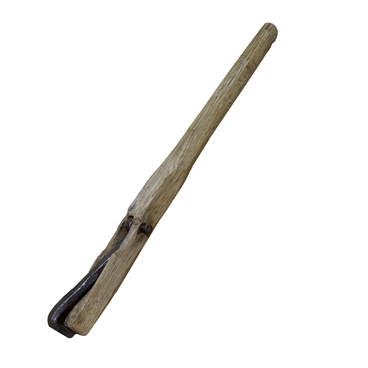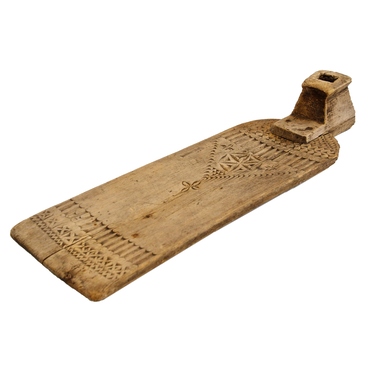From 1953 to 1969 a complex Mordovian ethnographic expedition led by Doctor habilitated of History, a senior researcher of the ethnography of the peoples of the Baltic and Volga region Vera Belitser worked in the territory of the Mordovian ASSR. Deputy Director for scientific work of the Mordovian Republican Museum of Local Ludmila Artamoshkina was also a member of the expedition, collecting and giving scientific description of the ethnographic items to replenish the Mordovian collection of the museum. Artamoshkina received the smoker from V. E. Makolov, a resident of the village Kildyushevo, Lukoyanovsky district, Gorkovsky region. It was registered in the museum funds on June 17, 1965.
The apiary smoker is a device with which the beekeeper creates and directs a stream of smoke to the desired location to calm insects. It is made in the form of a jug with an attached handle. The top of the neck is gently curved at a 45-degree angle and heavily tapered to form a spout for the smoke to escape. The edge of the spout is thickened. On its handle and the top five clay ovals are attached. The body of the smoker is decorated with scratched wavy lines and grooves. In the side part there is a hole for smoldering material.
This smoker was made in the late 19th century by craftsmen from the village of Bolshoye Kazarinovo, Sergachsky District, Nizhny Novgorod Province (now the Bolsheboldinsky District of Nizhny Novgorod Region). The village was famous for its unusual black clay pottery — black clay utensils with a metallic tint.
Mordovian beekeepers bought such smokers at local fairs. Inside, they placed available materials that produce thick smoke without a flame when smoldering — for example, dried rotten wood, tinder fungus, dried horse dung. The smoke was used to fume the beehive.
In Mordvin-Moksha the hive was called “neshkopar”, and in Erzya “neshkepar”. Both words are translated as “a bee tub”.
In the olden days, a beehive was a hollowed-out block of solid wood. They were installed on forest edges, meadows, in lime groves. Beehives of the Mordvin people were mentioned in the documents as early as from the 16th century. According to ethnographic data, “bee tubs” were used until the end of the 19th century, and then they were replaced by frame hives.
The apiary smoker is a device with which the beekeeper creates and directs a stream of smoke to the desired location to calm insects. It is made in the form of a jug with an attached handle. The top of the neck is gently curved at a 45-degree angle and heavily tapered to form a spout for the smoke to escape. The edge of the spout is thickened. On its handle and the top five clay ovals are attached. The body of the smoker is decorated with scratched wavy lines and grooves. In the side part there is a hole for smoldering material.
This smoker was made in the late 19th century by craftsmen from the village of Bolshoye Kazarinovo, Sergachsky District, Nizhny Novgorod Province (now the Bolsheboldinsky District of Nizhny Novgorod Region). The village was famous for its unusual black clay pottery — black clay utensils with a metallic tint.
Mordovian beekeepers bought such smokers at local fairs. Inside, they placed available materials that produce thick smoke without a flame when smoldering — for example, dried rotten wood, tinder fungus, dried horse dung. The smoke was used to fume the beehive.
In Mordvin-Moksha the hive was called “neshkopar”, and in Erzya “neshkepar”. Both words are translated as “a bee tub”.
In the olden days, a beehive was a hollowed-out block of solid wood. They were installed on forest edges, meadows, in lime groves. Beehives of the Mordvin people were mentioned in the documents as early as from the 16th century. According to ethnographic data, “bee tubs” were used until the end of the 19th century, and then they were replaced by frame hives.



